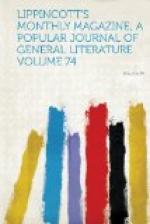And just as the East has bound itself fast to externals, so the Raskolnik praises his fossilism to the skies, and would gladly run the risk of petrifying society in its inherited shape. With him, as with the child or the Oriental, wisdom and science belong to the infancy of civilization, and the maxims of antiquity leave nothing to be learnt. Under both aspects the Old Believer is reactionary, opposed to the very principle of progress—the hero of routine and a martyr to prejudice. His gaze turns naturally to the past, and if reform ever enters his mind, he dreams of a return to the good old times of yore. Even his struggle against authority is based on the old idea of sovereignty: his political motto, as well as that of most of the people, is, “No emperor, but a czar!” The czar was one day pointed out to a Raskolnik conscript. “That is no czar,” he said: “he wears a moustache, a uniform and a sword, like all the rest of the officers. He is nothing but a general.” These worshipers of the past, with their devotion to ceremonial, think of the czar only as a long-bearded man in a flowing robe, such as they see in the ancient images. The Old Believers are the exaggerated representatives of the spirit of stagnation which everywhere confronts the Russian government. Nothing gives a clearer conception of the obstacles still in the way of reforms which elsewhere would be matters of course (as, for instance, the substitution of the Gregorian for the Julian calendar) than the resistance which other measures have already encountered.
In principle the Raskol is conservative, not to say reactionary, but its attitude toward the Church and the State, and the habits engendered by two centuries of opposition and persecution, give it a revolutionary, or even an anarchical, character. A secret tie unites all the branches of public authority, and the rejection of one leads to the rejection of another. As has been said by an eminent historian of Russia, the refusal to submit to a single form of authority brings into activity a disposition to rid one’s self of all social and moral ties. The Hussite revolt against Rome speedily results in the Taborite revolt against society: Luther calls the Anabaptists into being. The same phenomenon is repeated in Russia, in England and in Scotland. Once carried away by the spirit of revolt, an irresistible tendency sweeps the schism on in the direction of civil liberty; and both in theory and in practice some of these sects have reached the most unbridled license. Hence, by one of those contrasts which are so common in Russia, the Raskol is judged in two utterly different ways, each of which is partly correct. The reactionary movement in its inception had the appearance of an assertion of the rights of individual liberty and national life, as opposed to the autocratic government; and such it was, after a fashion—the fashion of refractory conscripts or of smugglers, not to say of brigands—the fashion, in short, in which




